Five years ago, self-publishing was a scar. Now it's a tattoo. -Greg White, in Bloomberg News, 2016

Up until two decades ago, self-publishing used to be described by the negative term vanity press with the connotation that the only reason that a book was being printed was to satisfy the author's personal ego. Authors were considered to have been insufficiently talented to have been published the 'proper' way via an established publishing house. Traditional publishers typically paid authors a percentage of the sales of their books, so publishers would select only those authors whose books they believed were likely to sell well. As a result, it was difficult for an unknown author to get a publishing contract under these circumstances. So-called vanity publishers offered an alternative: they would publish any book in exchange for an upfront payment by the author. With this arrangement, the author would not own the print run of finished books, and would not control how they were distributed. Critics of vanity publishers included James D. Macdonald, who claimed that vanity publishing violated Yog's Law which states that "Money should flow toward the author." Vanity publishing usually required a one-time payment of $5,000 to $10,000 to do a print run of 1000 books; these books usually ended up in boxes in a garage.
Self-published books have had an essential negative stigma. To be sure, self-publishing is sometimes seen as a sign that an author believes in his or her work; for instance, photographer-turned-publisher Max Bondi said that "investing in a project shows that you believe in it". Nevertheless, part of the reason for the negative stigma is that many self-published books, particularly in past decades, were of dubious quality. For example, in 1995, a retired TV repairman self-published his autobiography in which he described how he had been stepped on by a horse when he was a boy, how he had been almost murdered by his stepfather when he was a young man in Mexico, and how his ex-wife had clawed his face with her fingernails. The repairman spent $10,000 to have his 150-page masterpiece printed up, and, for promotion purposes, he sent copies to a local library, to the White House, and to everybody with the repairman's same last name. These efforts did not lead anywhere; today, the book is largely forgotten.

Even in the first decade of the 21st century, self-publishing was often seen as a 'mark of failure', although there are many indicators that this is changing. The image of self-publishing has been improving, since many well-known writers, who generate high quality content, have first started by self-publishing, or have switched from traditional publishing to self-publishing. According to some views, the stigma of self-publishing is gone entirely, while others feel that self-publishing still has a way to go to cultivate respectability. Book critic Ron Charles in the Washington Post complained in an opinion piece that 'No, I don’t want to read your self-published book', citing concerns that there were too many published authors, and that self-published books lacked quality, and were published by authors with little understanding of the audience or the market. But the negative stigma has been receding with the advent of dozens of authors who have self-published their way to literary success. Breakaway bestsellers such as Fifty Shades of Grey and The Martian were first self-published, helping to lend respectability to self-publishing in general. Further, with new avenues of self-publishing, there are more opportunities for authors to break through directly to audiences.
Today what constitutes vanity publishing is not clearly defined. An author who simply uploads a manuscript to an online service like Kindle or Smashwords, and who then expects a bestseller without doing vital marketing and promotion efforts, might be described as doing vanity publishing. Increasingly, vanity publishing is defined as a behavior rather than a definition of certain companies or individuals, although there remain a handful of companies that clearly qualify as vanity publishers. These companies offer the cachet of being published and make the majority of their income on fees for intangible services paid for by the author in advance of publication, rather than afterwards from sales revenue. Accordingly, the line between vanity publishing and traditional publishing has become increasingly blurred in recent years. Currently, there are several companies that offer digital and print publications, and textbooks with no upfront cost, although many of them offer fee-based services such as editing, marketing and cover design.